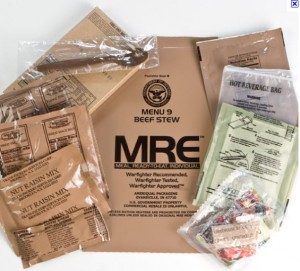I’m not going to waste time discussing taste or which meals are better than others because in a survival or tactical situation that is 100% irrelevant. Having taken these meals on hiking and camping trips the most obvious disadvantage to these as an emergency meal or bug-out-bag supplies are the weight and space. Before I pack an MRE I am going to strip off all the outer layers and cardboard and disregard anything that is not edible or useful. Even then they still take up weight and space. An advantage is that while you will feel starved and sapped of energy; you can sustain yourself respectably on a single meal a day. If you are inactive I wouldn’t eat more than a single meal a day, and no more than three if you are physically engaged.
Each meal will give you about 1,200 calories. Within the military organization they are intended to be eaten no more than 21 days in a row; if you haven’t relied on them, you’ll be feeling the effects after about two or three days. Depending on storage conditions they have a recommended shelf life of three years; however, if they are past the use by date they should not be thrown out, instead take one meal out and test it; if that meal has not gone bad then the entire case of 12 MREs is considered fit to eat. I don’t recall eating to many MREs made less than three years ago, and I know that they will stay fine for years passed that marker. You can look that up, but it’s the actual way you are supposed to do it within the military. The fact that people are still consuming rations made 20 plus years ago testifies to the possible shelf life of these things if stored cool and dry.
There were a lot of engineers involved with designing the meals and packaging. MREs must be able to withstand falls from 1,250 ft (about 380 meters) by parachute. At 81 °F the packaging has to be able to withstand 3.5 years of shelf life without deteriorating; and short durations from −60 °F to 120 °F have to be sustainable. So the cardboard cases and internal packaging are designed to take a beating, which is useful if they are getting tossed about and used as chairs and tables.
Each MRE will weigh between 18 to 26 oz fully packed, depending on the menu; if you’re doing the math that about 1 to 1.5 lbs (that’s why I strip them down). One of the reasons they weigh more than other survival foods is that they contain water. If you are concerned with weight there are freeze-dried alternatives that will pack the same caloric content. It’s worth considering how many calories you will need depending on the environment of operation; bearing in mind that when it is cold you can burn up to five times as many calories. During field exercises in the army we will typically function off two meals a day. My brother at Marine Basic lived of a meal a day during the crucible, and another guy I know did the same at Ranger School; both stated that it sucked, but you learn to be hungry and drive on.
One major drawback to MREs is their low dietary fiber which result in constipation problems; if your guts aren’t used to them expect two or three days before you take your first bowel movement. There are myths that the gum found in MREs contains a laxative, but that is false (however, they are sweetened with xylitol, which has a mild laxative effect). The crackers in the meal do contain a higher than normal vegetable content to help facilitate digestion. Many items are fortified with nutrients.
Some “hard core” guys will boast how amazing MRE bombs are, but they typically produces no more than a loud pop with occasionally mildly flammable gasses; it’s anti climatic. However emptying the heater content into an empty bottle with a hole poked in the cap and then pouring in a watered down tabasco mixture will produce some fun eye and lung irritating gasses. In reality neither of these has any combat effective value and are better left as cheap gags or pranks. You can look it up on the internet; but you’re not likely to find a “30 ways to kill a dude with an MRE” list with any real practicality.
The things worth holding onto after consumption of an MRE after the food is consumed are the spoon, matches, seasoning, toilette paper, and wet wipes. If it is cold put the MRE heater inside your coat during or after the meal is prepped and I’ll help warm you up like a pocket warmer. I’d recommend eating the entire meal if you are in an emergency situation; squeeze all that cheese or peanut butter out and make the calories count because you’ll need them.
General contents may include:
- Main course (entree)
- Side dish
- Dessert or snack (often commercial candy, fortified pastry, or HOOAH! Bar)
- Crackers or bread
- Spread of cheese, peanut butter, or jelly
- Powdered beverage mix: fruit flavored drink, cocoa, instant coffee or tea, sport drink, or dairy shake.
- Utensils (usually just a plastic spoon)
- Flameless ration heater (FRH)
- Beverage mixing bag
- Accessory pack:
- Xylitol chewing gum
- Water-resistant matchbook
- Napkin / toilet paper
- Moist towelette
- Seasonings, including salt, pepper, sugar, creamer, and/or Tabasco sauce


Leave a Reply